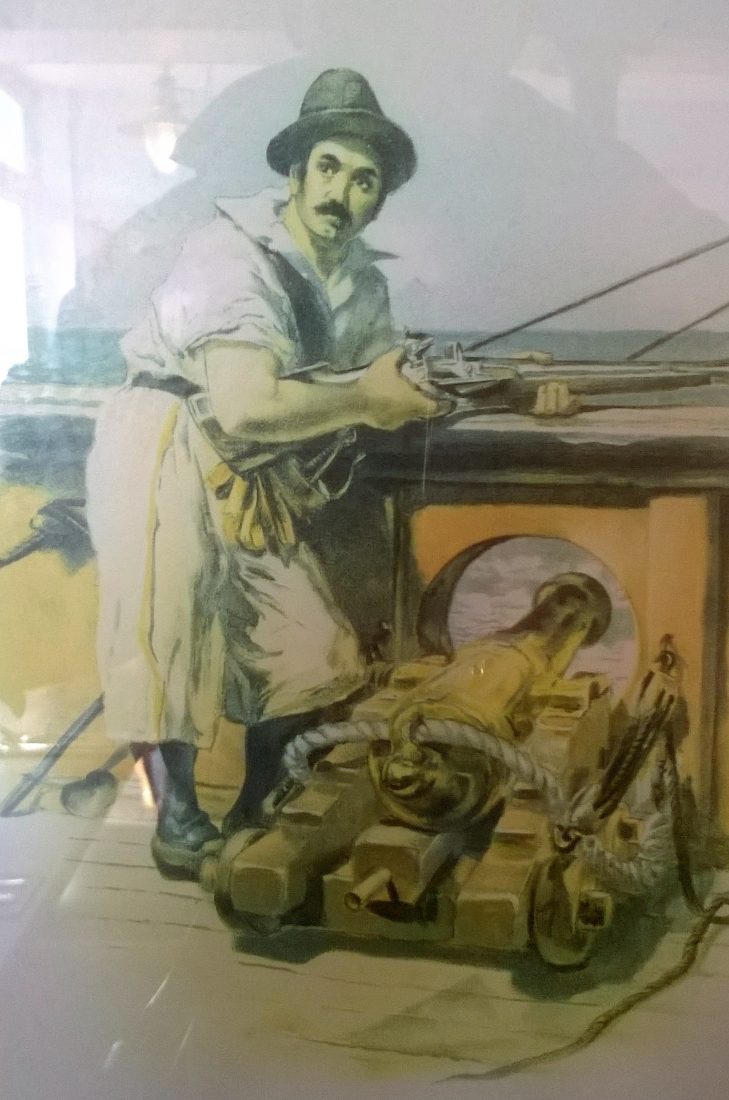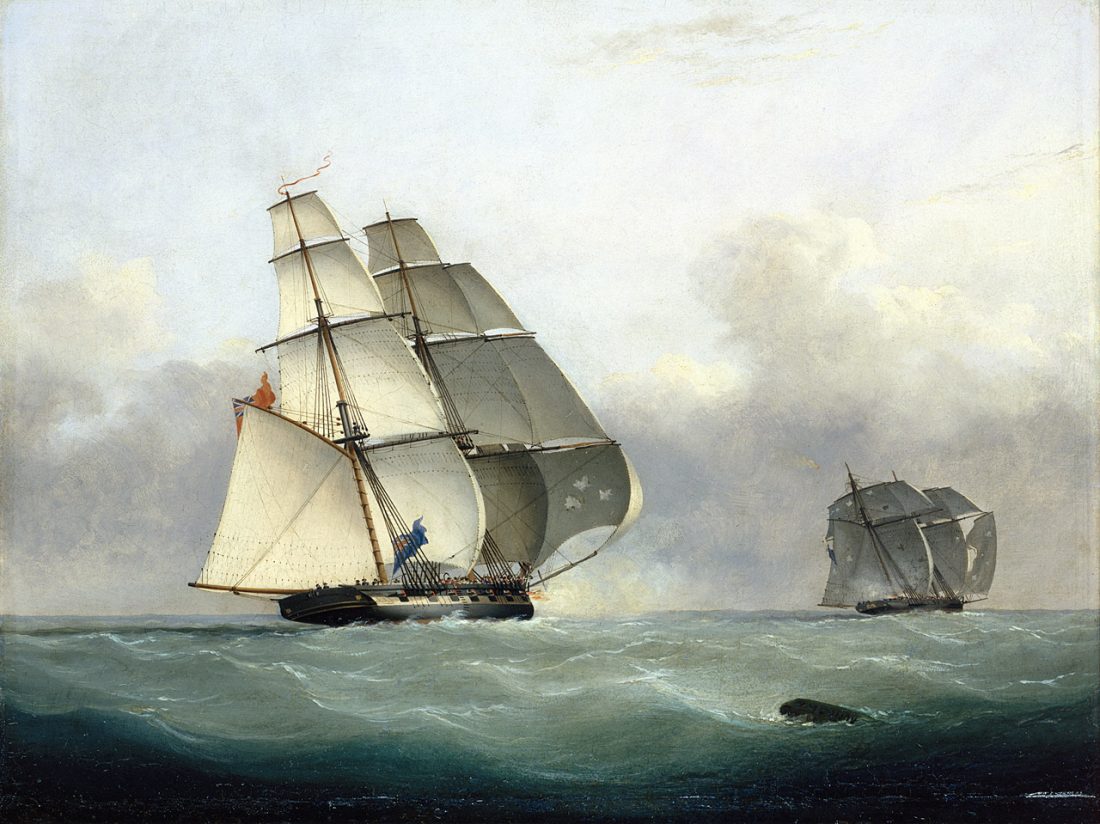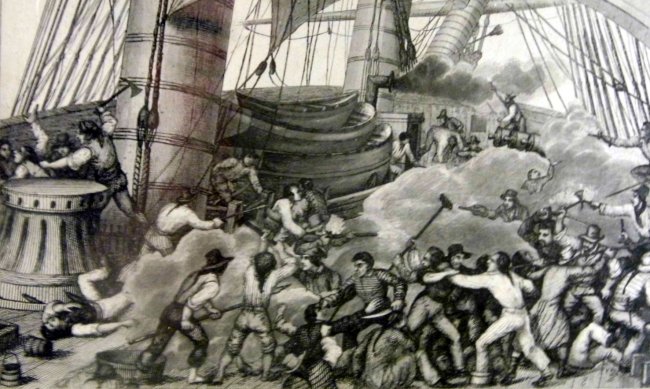HMS Dolphin and the capture of the slaver Firme, 1841

Early 19th Century Slaver
In 1807 Britain was the first nation to outlaw the slave trade, one which had existed for millennia (and that, to a certain extent, still does). Active measures to suppress the evil had to wait until the end of the Napoleonic Wars, when other nations also followed suit one by one. The next four decades saw Britain, more than any other country, dedicate significant naval forces to the interception and capture of vessels active in the Atlantic slave trade between West Africa and the Americas. In the latter half of the century, efforts were also made to supress the Indian Ocean slave trade between East Africa and Arabia. The duty was one that demanded initiative and courage from officers and crews alike, not least because of the heavy toll taken by malaria at operational bases such as Lagos in Nigeria.
The size and nature of the ships engaged in the trade changed after it was declared illegal. Prior to that time large ships carried hundreds of slaves, quite legally and without fear of let or hindrance. Once the trade was outlawed however, the need was for small ships, carrying small numbers of captives but fast enough to outrun any naval vessel hunting them and sufficiently armed to fight them off if they could not.
An example of just how dangerous such service could be was illustrated by an action by HMS Dolphin in 1841 – one in which speed could play no role due to calm conditions and success had to depend on the bloody-mindedness of her crew. HMS Dolphin, a brigantine of 320 tons had been launched in 1836. Lightly armed, with three guns only, she was built for speed, making her ideal for anti-slavery work and for this she was to spend five years from 1837 on the West Africa Station. The account that follows relies heavily on Edward Giffard’s classic “Deeds of Naval Daring”, published in 1852. Giffard’s account does not, tantalisingly, mention the name of HMS Dolphin’s captain.

HMS Dolphin in action against a slaver – contemporary print
At daylight on 30th May, 1841, HMS Dolphin was on patrol off Whydah (today known as Ouidah, in the Benin Republic) when another brigantine was sighed and suspected to be a slaver. The area had a long slaving history – the Portuguese had built a small fort there in 1721 and large numbers of slaves had been shipped from it to Brazil, then still a Portuguese possession. The trade continued, though on a much-reduced scale, after the trade was outlawed.
HMS Dolphin, still close inshore, set all sail and, with a strong land wind in her favour, gained on the stranger. The breeze died away however, raising the possibility that, if the wind rose again, the other vessel might escape. HMS Dolphin’s commander therefore took the decision to send two pulling boats to attack, a 20-foot cutter with the mate, a Mr. Murray, and eight seamen and a 22-foot gig with the second master, a Mr. Rees, and five seamen. Squalls and rain during the night just ended had meant the boat crews had been kept constantly at work trimming sails and were fatigued when they set out, and without breakfasts. The puling on the oars must have been exhausting – the sun was well up by now and burning hot. The chase lasted nearly three hours before the boats, now with colours raised and the gig slightly ahead of the cutter, closed with their quarry. No sign of life was visible but, suddenly, “her bulwarks bristled with muskets, and a rattling volley was fired into the gig.” Rees ordered his crew to drop their oars and return fire, gaining thereby a respite that allowed them to draw away and wait for the cutter to catch up. After it did, and as the two boats advanced together, a sea-breeze began to rise.

Another classic action: The capture of the slaver Gabriel by HMS Acorn, 6 July 1841 Painting by Nicolas Matthew Condy. (With thanks to National Maritime Museum, Greenwich)
The brigantine got under way with the freshening breeze – she had already run out her sweeps (laree oars) to prevent HMS Dolphin’s boats approaching alongside and musket fire was being maintained from her upper deck and two cabin windows. According to Giffard: “The boats advanced together, cheering heartily, and as the stern of the brigantine lifted with the swell, they ran in under the two aftermost sweeps, one on each side. At this moment the bowman of the gig, William Allen, was shot through the heart in the act of laying his oar in, and the bowman of the cutter, William Jacobs, met with a similar fate and went overboard. Mr. Murray was on the brigantine’s deck almost as his boat touched her side, but was knocked again with his collar-bone broken by the butt- end of a musket; again he clambered up and received a cutlass cut upon his left arm, which nearly severed the hand at the wrist, while he fortunately parried a desperate blow aimed at the same time at his head, and struck down his assailant.”

Boarding: When large-scale, as here, or small-scale in the case of HMS Dolphin’s crew’s attack, it was always brutal and bloody
Another hero of the action was John Smith, “an old and first-rate seaman, had closely supported his officer during the mélée and although his right arm was disabled and badly fractured by the blow of a cutlass, he continued to defend himself with his sword in his left hand against three men who pressed him hardly.” In the meanwhile, Rees and the gig’s crew had cleared the bulwarks on the opposite side of the deck and now “advanced most opportunely to Mr. Murray’s assistance, wounding one of his assailants and running another through the body, while the third, who fled precipitately, was brought down by a flying shot.” The crews of both boats now rushed together on the remnants of the slaver’s crew “who discharged their remaining loaded muskets, and jumped down the hatchways” leaving HMS Dolphin’s men in possession of the ship. The battle had lasted some twenty minutes – it must have been a brutal business in so small a space and it had cost the lives of two of HMS Dolphin’s men and left two others seriously wounded. The captured slaver proved to be the Firme, a beautiful vessel of 179 tons.
Giffard tells nothing of what followed. Was the Firme actually carrying slaves and, if so, how many? Were the slavers tried, imprisoned or hanged? Was the Firme judged to be a prize by an adjudicating court and if so, by how much did HMS Dolphin’s crew and her un-named captain benefit?
An interesting postscript was that HMS Dolphin still had fifty-three years of service ahead of her, thirty of them for the Royal Navy on overseas stations and the remainder in Customs duty in British waters. The tax-payer had got a bargain when she was built!
s
 1866: it’s four years since France invaded Mexico and set up a new ‘Mexican Empire’ with a puppet emperor imported from Europe but armies loyal to the republican government still resist. In a land devastated by battles, atrocities and reprisals, the tide of war is now turning in favour of the republic’s ‘Juarista’ supporters. France recognises that the war is unwinnable and evacuation inevitable, but first there will be bitter rearguard actions and old scores to settle.
1866: it’s four years since France invaded Mexico and set up a new ‘Mexican Empire’ with a puppet emperor imported from Europe but armies loyal to the republican government still resist. In a land devastated by battles, atrocities and reprisals, the tide of war is now turning in favour of the republic’s ‘Juarista’ supporters. France recognises that the war is unwinnable and evacuation inevitable, but first there will be bitter rearguard actions and old scores to settle.
Britain is neutral in this conflict, but large British interests – railway and mining enterprises – are at risk as the war-front edges ever closer. Investors in London are demanding British action to protect their assets.
Sub-Lieutenant Nicholas Dawlish is serving on the Pacific Station in the gunvessel HMS Sprightly. She, and her resourceful captain, are tasked with taking ‘appropriate’ action to guarantee the safety of these interests. The situation is complex – not only Juarista, French and Imperial Mexican forces but bandit groups, a volunteer Belgian Legion and ex-Confederate mercenaries are involved. And there’s a powerful ironclad, flying Imperial Mexican colours, commanded by an Austrian aristocrat who’s desperate for glory.
Dawlish is plunged into deadly action by land and sea and, with fluency in French and Spanish, he’ll be his captain’s right-hand man in a web of political intrigue, treachery and greed in which a single mistake can end both their careers.
But for Dawlish there’s something worse, a heart-breaking encounter with a figure from his past to whom he’s linked by a solemn promise that he can’t fulfill. What follows will be torment for his emotions and his conscience . . .
Available in Large Paperback and Kindle formats. Kindle Unlimited subscribers can read at no extra charge. Kindle version available for pre-order. Click the marketplaces below for ordering details:
United States Canada
United Kingdom Australia & New Zealand
Below are the twelve Dawlish Chronicles novels published to date, shown in chronological order. All can be read as “stand-alones”. Click on the covers below for more information. All are available in Paperback or Kindle format and can be read at no extra charge by Kindle Unlimited Subscribers.
Six free short-stories are available for download to your Kindle. Access them by registering for the Dawlish Chronicles mailing list – just click on the banner below. You’ll be kept updated on new books and will receive other free stories at intervals.





